Relationship between Spatio-Temporal Travel Patterns Derived from Smart-Card Data and Local Environmental Characteristics of Seoul, Korea
Abstract
:1. Introduction
2. Study Area and Data Preparation
2.1. Study Area
2.2. Smart-Card Data
2.3. Local Environmental Data
2.4. Unit Area and Data Preparation
3. Methods
3.1. Aggregate Human-Mobility Patterns from Smart-Card Records
3.1.1. Road-Based Mobility Distribution
3.1.2. Clustering Analysis
3.1.3. Cluster Validity Measures
3.2. Relating Mobility Pattern and Local Environmental Characteristics
3.2.1. Variable Reduction Using Principal Component Analysis (PCA)
3.2.2. Multiple Correspondence Analysis (MCA)
4. Results and Discussion
4.1. Clustering (Analysis of Human Activities from the Aggregated Perspective)
4.1.1. Clustering Validity
4.1.2. Temporal Pattern of Public-Transit Passengers
4.1.3. Temporal Pattern of Public-Transit Passengers
4.2. Relating Mobility Pattern with Local Environmental Characteristics
4.2.1. Descriptive Analysis
4.2.2. Selected Variables (Local Environments) Using PCA
4.2.3. Relationship between Mobility Pattern and local Environments
5. Conclusions
Acknowledgments
Author Contributions
Conflicts of Interest
References
- Frankhauser, P. From fractal urban pattern analysis to fractal urban planning concepts. In Computational Approaches for Urban Environments; Springer International Publishing: New York, NY, USA, 2015; pp. 13–48. [Google Scholar]
- Rodrigues da Silva, A.N.; Manzato, G.G.; Pereira, H.T.S. Defining functional urban regions in bahia, brazil, using roadway coverage and population density variables. J. Transp. Geogr. 2014, 36, 79–88. [Google Scholar] [CrossRef]
- Lin, T.; Sun, C.; Li, X.; Zhao, Q.; Zhang, G.; Ge, R.; Ye, H.; Huang, N.; Yin, K. Spatial pattern of urban functional landscapes along an urban–rural gradient: A case study in xiamen city, china. Int. J. Appl. Earth Obs. Geoinf. 2016, 46, 22–30. [Google Scholar] [CrossRef]
- Veneri, P. The identification of sub-centres in two italian metropolitan areas: A functional approach. Cities 2013, 31, 177–185. [Google Scholar] [CrossRef]
- Cats, O.; Wang, Q.; Zhao, Y. Identification and classification of public transport activity centres in stockholm using passenger flows data. J. Transp. Geogr. 2015, 48, 10–22. [Google Scholar] [CrossRef]
- Zhong, C.; Schläpfer, M.; Arisona, S.M.; Batty, M.; Ratti, C.; Schmitt, G. Revealing centrality in the spatial structure of cities from human activity patterns. Urban Stud. 2017, 54, 437–455. [Google Scholar] [CrossRef]
- Yuan, N.J.; Zheng, Y.; Xie, X.; Wang, Y.; Zheng, K.; Xiong, H. Discovering urban functional zones using latent activity trajectories. IEEE Trans. Knowl. Data Eng. 2015, 27, 712–725. [Google Scholar] [CrossRef]
- Toole, J.L.; Ulm, M.; González, M.C.; Bauer, D. Inferring land use from mobile phone activity. In Proceedings of the ACM SIGKDD International Conference on Knowledge Discovery and Data Mining, Beijing, China, 12–16 August 2012; pp. 1–8. [Google Scholar]
- Pan, H.; Shen, Q.; Zhang, M. Influence of urban form on travel behaviour in four neighbourhoods of shanghai. Urban Stud. 2009, 46, 275–294. [Google Scholar]
- Ganciu, A.; Balestrieri, M.; Imbroglini, C.; Toppetti, F. Dynamics of metropolitan landscapes and daily mobility flows in the italian context. An analysis based on the theory of graphs. Sustainability 2018, 10, 596. [Google Scholar] [CrossRef]
- Jiang, B.; Yao, X. Geospatial Analysis and Modelling of Urban Structure and Dynamics; Springer: Dordrecht, The Netherlands, 2010. [Google Scholar]
- Loidl, M.; Wallentin, G.; Cyganski, R.; Graser, A.; Scholz, J.; Haslauer, E. Gis and transport modeling—strengthening the spatial perspective. ISPRS Int. J. Geo-Inf. 2016, 5, 84. [Google Scholar] [CrossRef]
- Dominic, S. Relationships between land use, socioeconomic factors, and travel patterns in britain. Environ. Plan. B Plan. Des. 2001, 28, 499–528. [Google Scholar]
- Schwanen, T.; Dijst, M.; Dieleman, F.M. The Relationship between Land Use and Travel Patterns: Variations by Household Type; Utrecht University Repository: Utrecht, The Netherlands, 2005. [Google Scholar]
- Boarnet, M.G.; Crane, R. Travel by Design: The Influence of Urban Form on Travel; Oxford University Press on Demand: Oxford, UK, 2001. [Google Scholar]
- Milakis, D.; Efthymiou, D.; Antoniou, C. Built environment, travel attitudes and travel behaviour: Quasi-longitudinal analysis of links in the case of greeks relocating from us to Greece. Sustainability 2017, 9, 1774. [Google Scholar] [CrossRef]
- Handy, S. Methodologies for exploring the link between urban form and travel behavior. Transp. Res. Part D Transp. Environ. 1996, 1, 151–165. [Google Scholar] [CrossRef]
- Jen-Jia, L.; An-Tsei, Y. Structural analysis of how urban form impacts travel demand: Evidence from Taipei. Urban Stud. 2009, 46, 1951–1967. [Google Scholar]
- Calabrese, F.; Diao, M.; Di Lorenzo, G.; Ferreira, J.; Ratti, C. Understanding individual mobility patterns from urban sensing data: A mobile phone trace example. Transp. Res. Part C Emerg. Technol. 2013, 26, 301–313. [Google Scholar] [CrossRef]
- Ma, X.; Wu, Y.-J.; Wang, Y.; Chen, F.; Liu, J. Mining smart card data for transit riders’ travel patterns. Transp. Res. Part C Emerg. Technol. 2013, 36, 1–12. [Google Scholar] [CrossRef]
- Goulet-Langlois, G.; Koutsopoulos, H.N.; Zhao, J. Inferring patterns in the multi-week activity sequences of public transport users. Transp. Res. Part C Emerg. Technol. 2016, 64, 1–16. [Google Scholar] [CrossRef]
- Roth, C.; Kang, S.M.; Batty, M.; Barthélemy, M. Structure of urban movements: Polycentric activity and entangled hierarchical flows. PLoS ONE 2011, 6, e15923. [Google Scholar] [CrossRef] [PubMed]
- Seoul Metropolitan Government. Seoul Public Transportation Story by Numbers; Transportation Policy Department, Seoul Metropolitan Government: Seoul, Korea, 2014.
- Seoul Solution. Establishing Transportation Card System. Available online: https://seoulsolution.kr/ko/content/%EA%B5%90%ED%86%B5%EC%B9%B4%EB%93%9C%EC%8B%9C%EC%8A%A4%ED%85%9C-%EA%B5%AC%EC%B6%95 (accessed on 9 September 2017).
- MOI. Resident Registration Data. Available online: http://rcps.egov.go.kr:8081/jsp/stat/ppl_stat_jf.jsp (accessed on 18 May 2016).
- Seoul Statistics. Transportation Modes of Seoul Citizen. Available online: http://stat.seoul.go.kr/jsp3/stat.db.jsp (accessed on 18 May 2016).
- SGIS. Explanation of Term. Available online: http://211.34.86.29/contents/support/support_04.jsp (accessed on 7 November 2017).
- Jeon, J. Demarcation of Statistical Area. Available online: http://kostat.go.kr/portal/korea/kor_nw/2/14/1/index.board?bmode=read&aSeq=56336 (accessed on 18 May 2016).
- Cockings, S.; Martin, D. Zone design for environment and health studies using pre-aggregated data. Soc. Sci. Med. 2005, 60, 2729–2742. [Google Scholar] [CrossRef] [PubMed]
- Yuan, N.J.; Zheng, Y.; Xie, X. Segmentation of Urban Areas Using Road Networks; Technical Report MSR-TR-2012-65; Microsoft: Albuquerque, NM, USA, 2012. [Google Scholar]
- Langford, M. An evaluation of small area population estimation techniques using open access ancillary data. Geogr. Anal. 2013, 45, 324–344. [Google Scholar] [CrossRef]
- Xie, Y. The overlaid network algorithms for areal interpolation problem. Comput. Environ. Urban Syst. 1995, 19, 287–306. [Google Scholar] [CrossRef]
- Lee, K. Impacts of neighborhood’s land use and transit accessibility on residents’ commuting trips—A case study of seoul. J. Korea Acad.-Ind. Coop. Soc. 2013, 14, 4593–4601. [Google Scholar] [CrossRef]
- City Planning Department. Seoul Metropolitan City Planning Decree; Seoul Metropolitan Government: Seoul, Korea, 2018; Volume 6776.
- Wang, H.; Wang, W.; Yang, J.; Yu, P.S. Clustering by pattern similarity in large data sets. In Proceedings of the ACM SIGMOD International Conference on Management of Data, Madison, Wisconsin, 3–6 June 2002; Moon, M.F.B., Ailamaki, A., Eds.; pp. 394–405. [Google Scholar]
- Kriegel, H.-P.; Kröger, P.; Zimek, A. Clustering high-dimensional data: A survey on subspace clustering, pattern-based clustering, and correlation clustering. ACM Trans. Knowl. Discov. Data 2009, 3, 1–58. [Google Scholar] [CrossRef]
- Gonzalez, M.C.; Hidalgo, C.A.; Barabasi, A.L. Understanding individual human mobility patterns. Nature 2008, 453, 779–782. [Google Scholar] [CrossRef] [PubMed]
- Yang, J.; Leskovec, J. Patterns of temporal variation in online media. In Proceedings of the 4th ACM International Conference on Web Search and Data Mining, Hong Kong, China, 9–12 February 2011; pp. 177–186. [Google Scholar]
- Caliński, T.; Harabasza, J. A dendrite method for cluster analysis. Commun. Stat.-Theory Methods 1974, 3, 1–27. [Google Scholar] [CrossRef]
- Hartigan, J.A. Clustering Algorithms; John Wiley & Sons, Inc.: New York, NY, USA, 1975. [Google Scholar]
- Kaufman, L.; Rousseeuw, P.J. Finding Groups in Data: An Introduction to Cluster Analysis; John Wiley & Sons: New York, NY, USA, 2009. [Google Scholar]
- Xie, X.L.; Beni, G. A validity measure for fuzzy clustering. IEEE Trans. Pattern Anal. Mach. Intell. 1991, 13, 841–847. [Google Scholar] [CrossRef]
- Rousseeuw, P.J. Silhouettes: A graphical aid to the interpretation and validation of cluster analysis. J. Comput. Appl. Math. 1987, 20, 53–65. [Google Scholar] [CrossRef]
- Sugar, C.A.; James, G.M. Finding the number of clusters in a dataset: An information-theoretic approach. J. Am. Stat. Assoc. 2003, 98, 750–763. [Google Scholar] [CrossRef]
- Wang, F. Quantitative Methods and Applications in Gis; CRC Press: Boca Raton, FL, USA, 2006. [Google Scholar]
- Abdi, H.; Valentin, D. Multiple correspondence analysis. In Encyclopedia of Measurement and Statistics; SAGE Publications: Thousand Oaks, CA, USA, 2007; pp. 651–657. [Google Scholar]
- Guo, Y. Knowledge Discovery for Design Optimization Using Correspondence Analysis; Simon Fraser University: Burnaby, BC, Canada, 2015. [Google Scholar]
- Jun, M.J.; Choi, S.; Wen, F.; Kwon, K.H. Effects of urban spatial structure on level of excess commutes: A comparison between seoul and los angeles. Urban Stud. 2018, 55, 195–211. [Google Scholar] [CrossRef]
- Kim, J.I.; Yeo, C.H.; Kwon, J.-H. Spatial change in urban employment distribution in seoul metropolitan city: Clustering, dispersion and general dispersion. Int. J. Urban Sci. 2014, 18, 355–372. [Google Scholar] [CrossRef]
- Koo, H.; Lee, B.; Lee, C.S. Analysis of changes in spatial structure of seoul by analyzing the land price changes of station influence areas. J. Korean Soc. Surv. Geodesy Photogramm. Cartogr. 2016, 34, 63–70. [Google Scholar] [CrossRef]
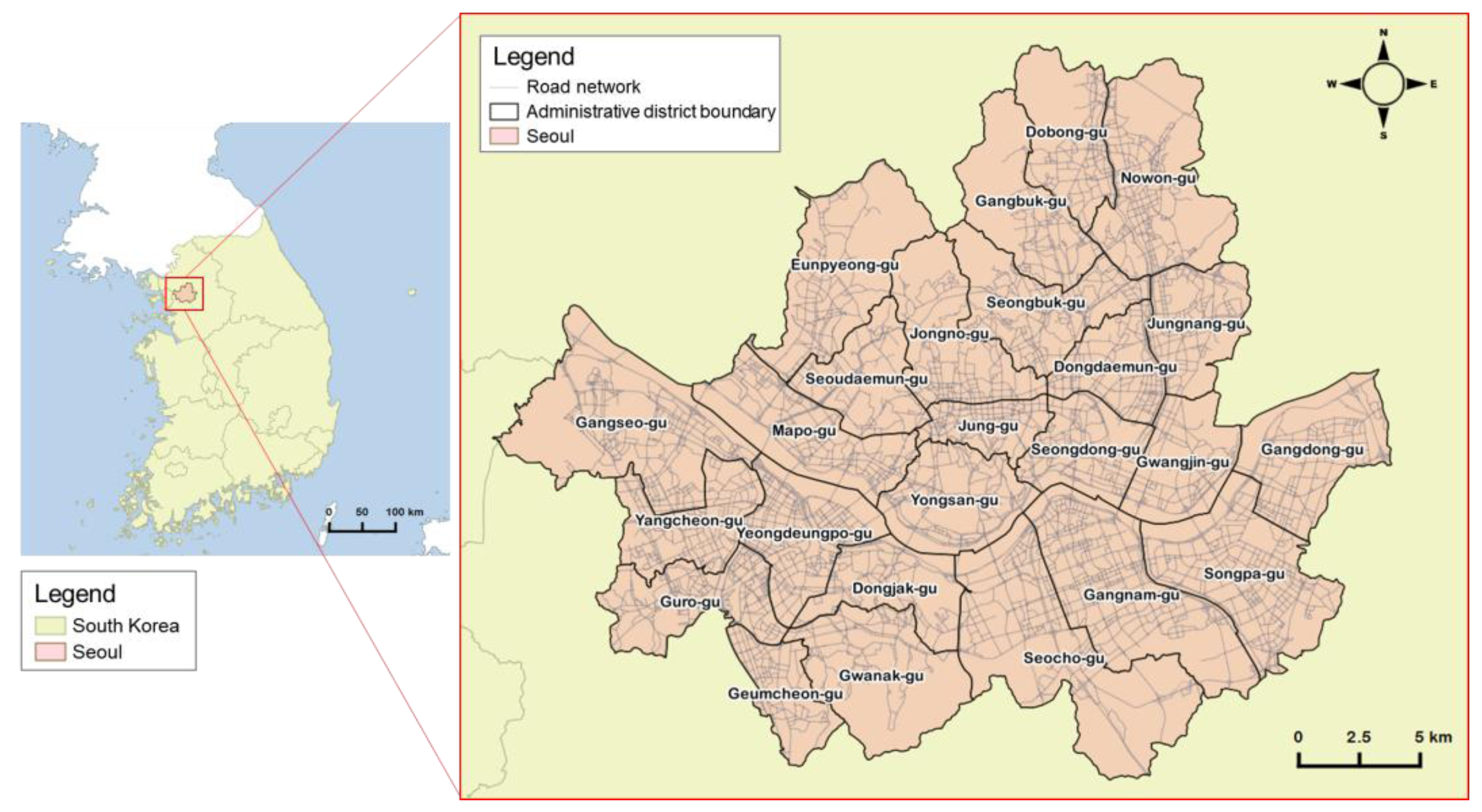
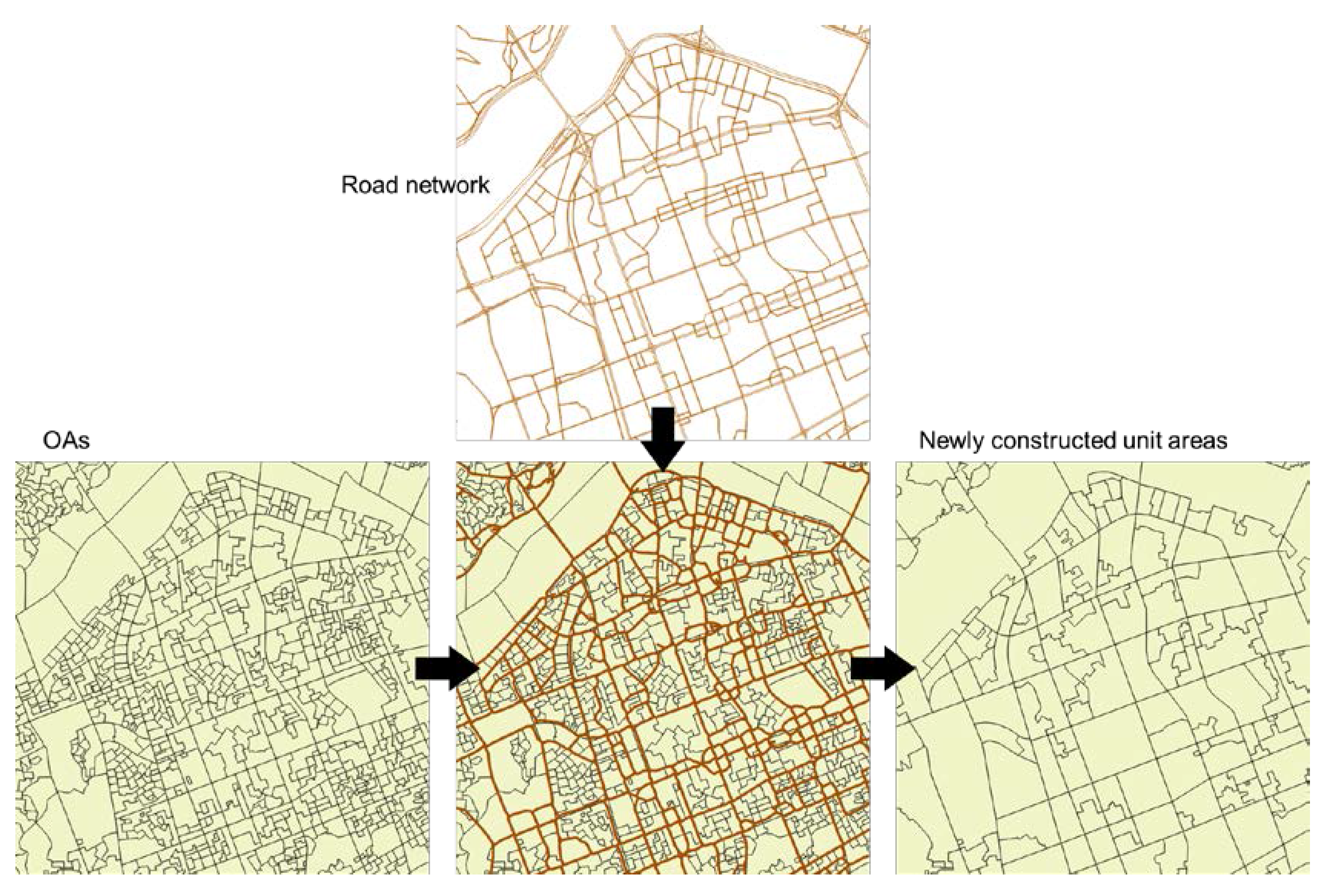

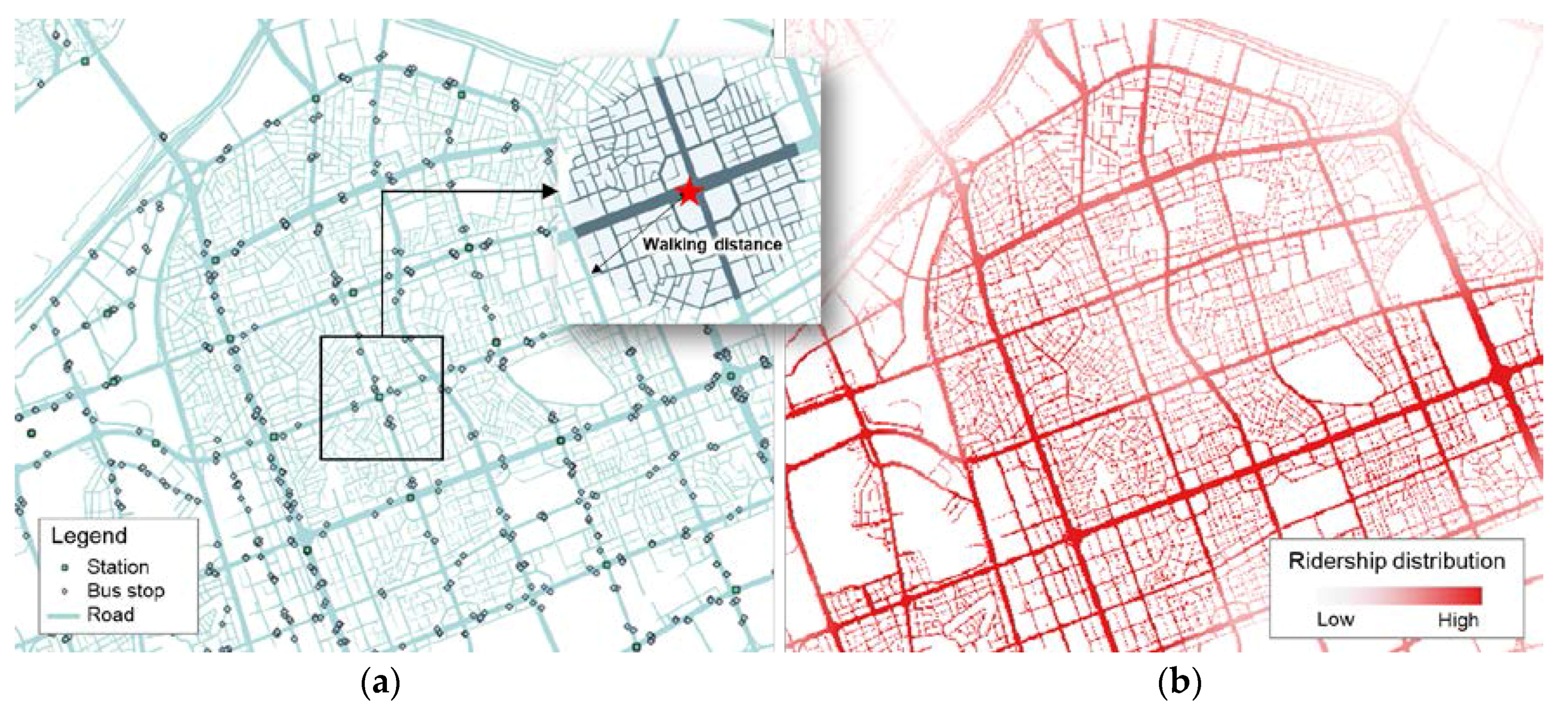
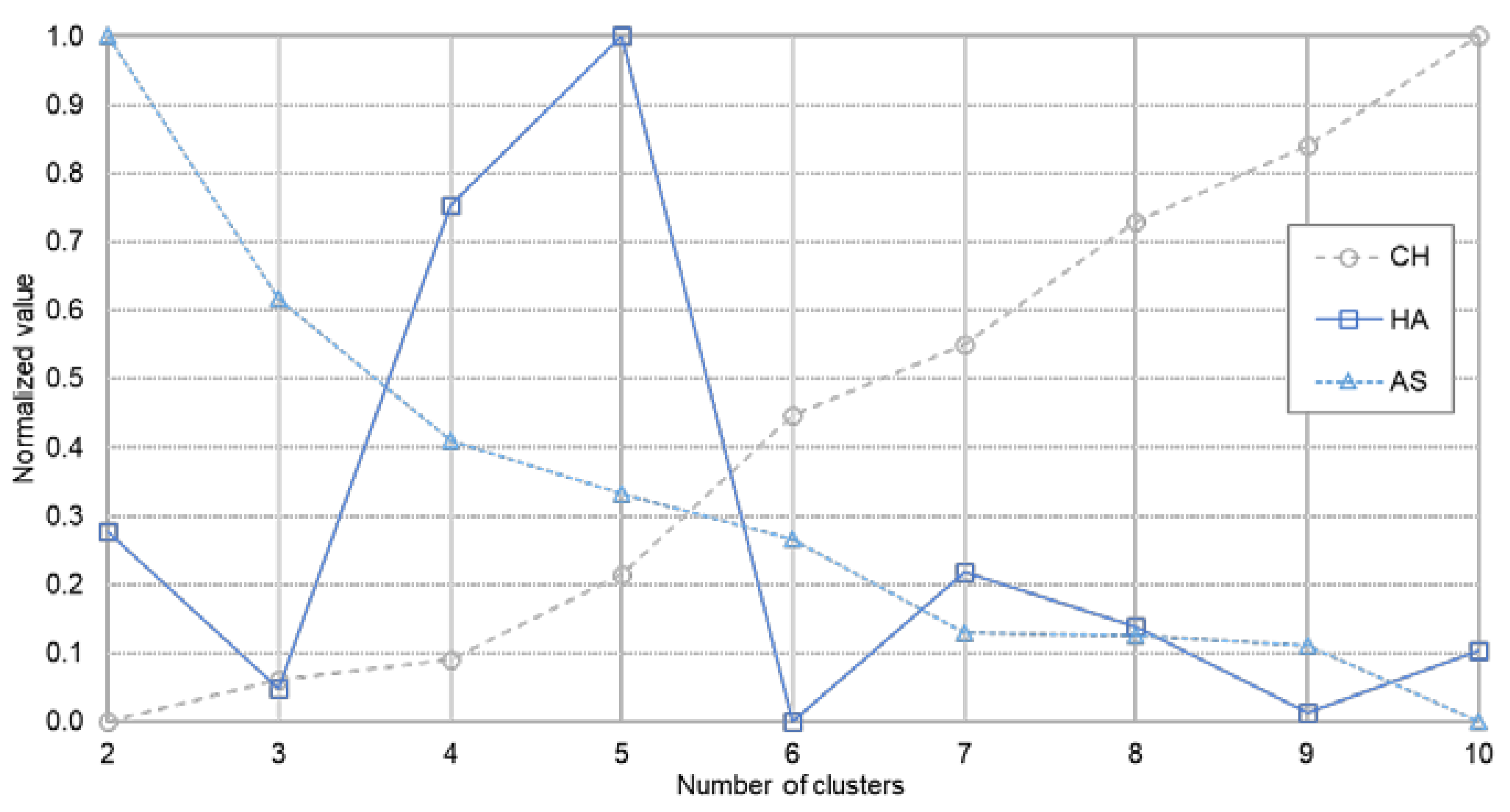


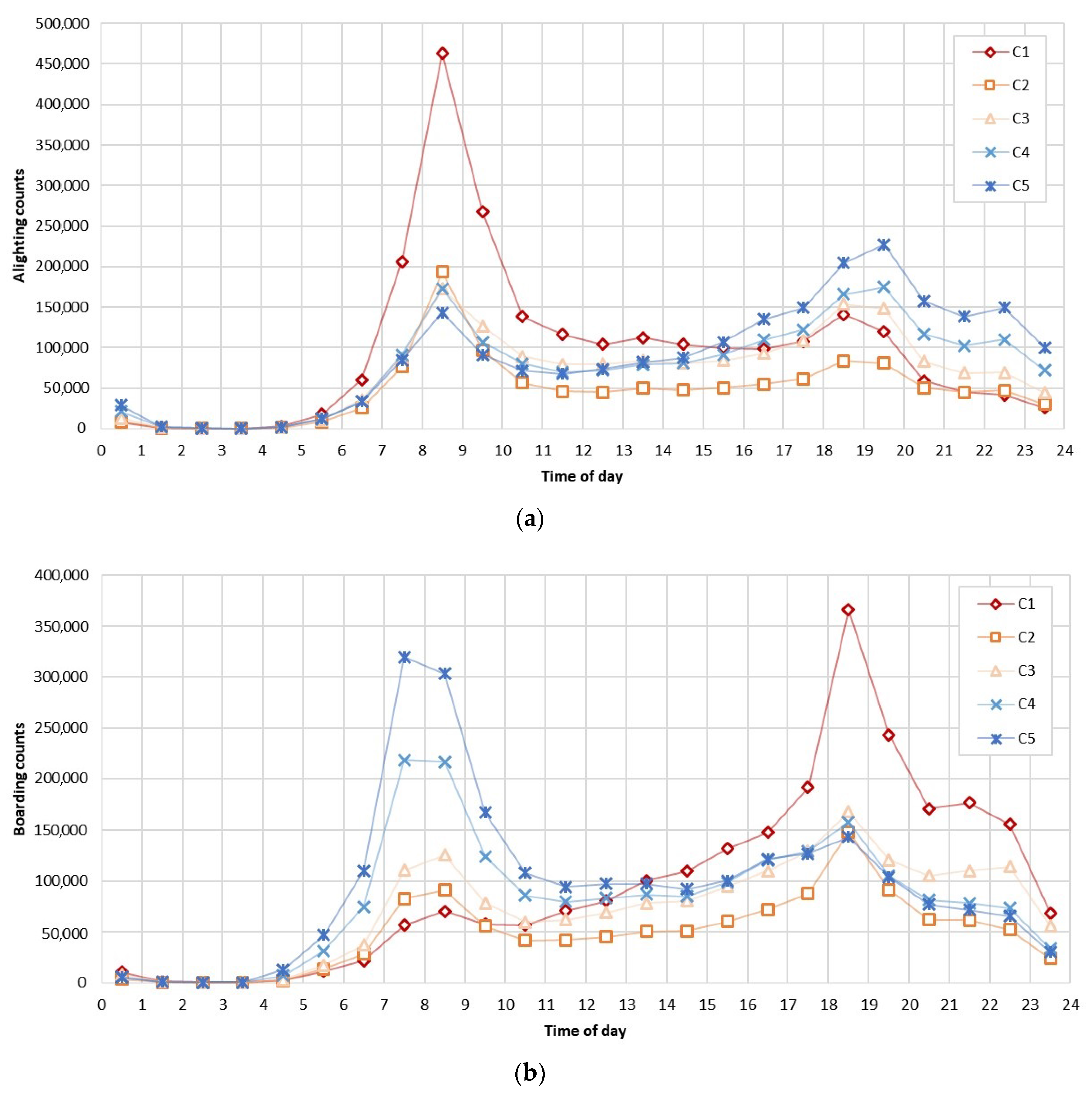
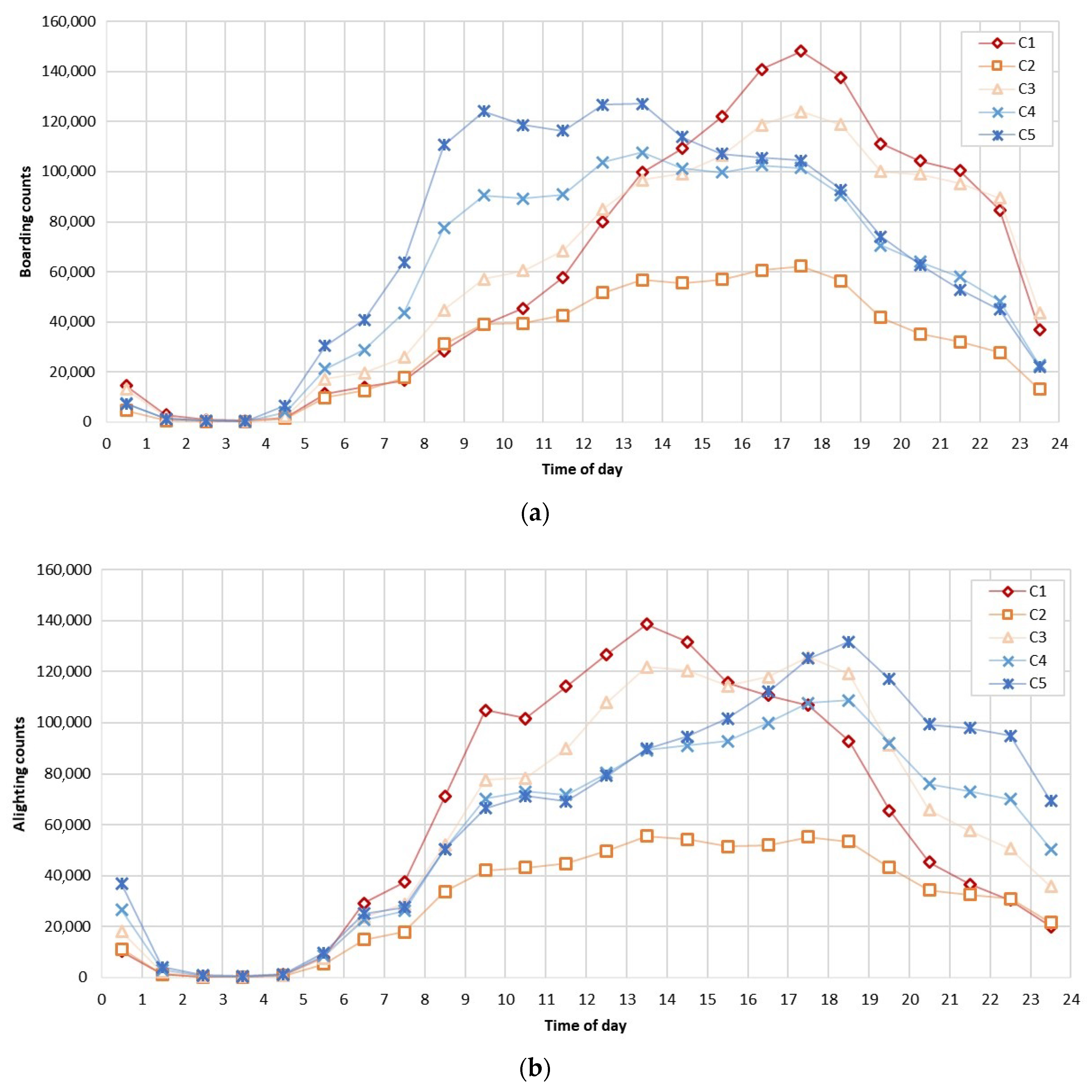
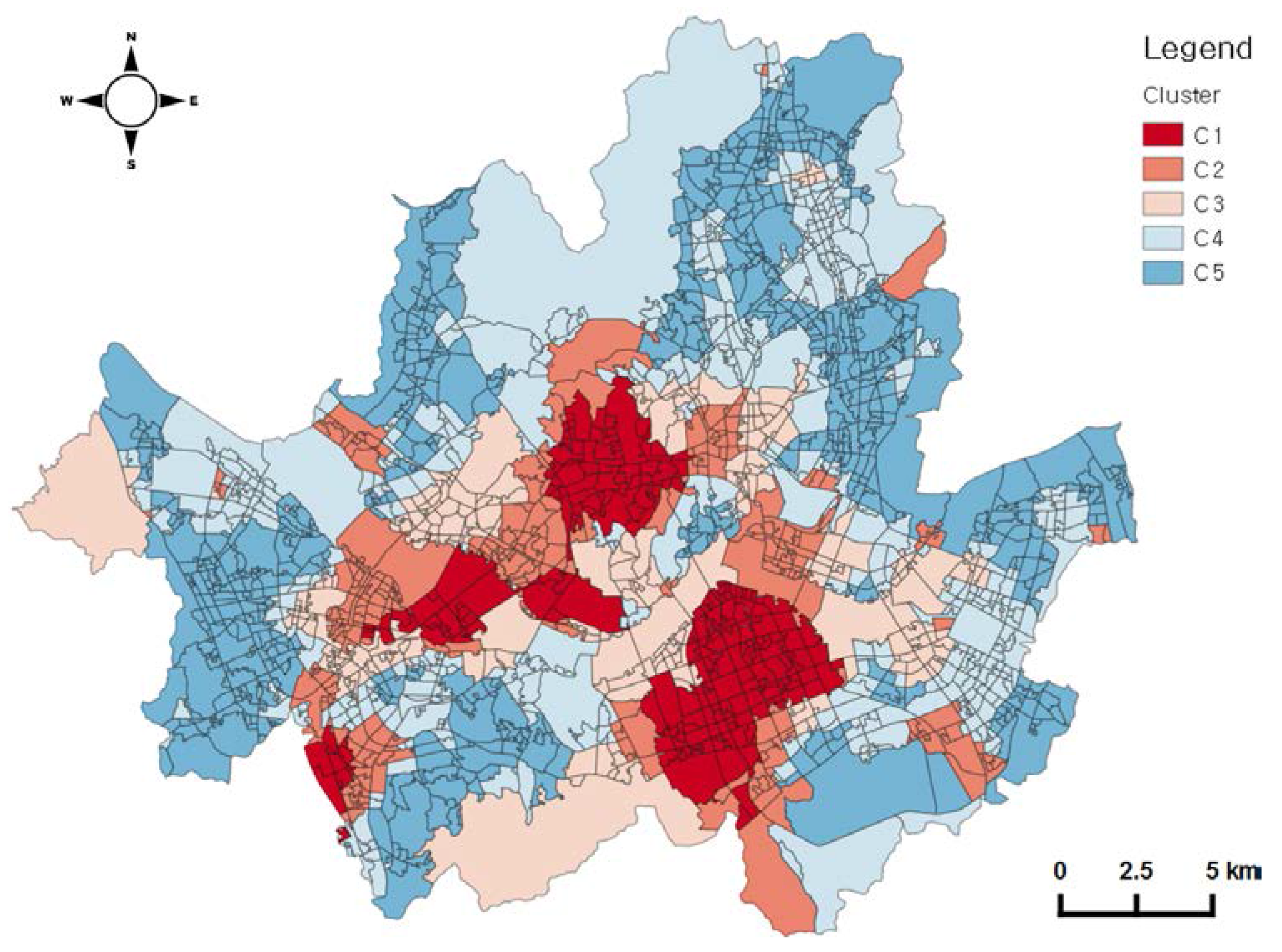
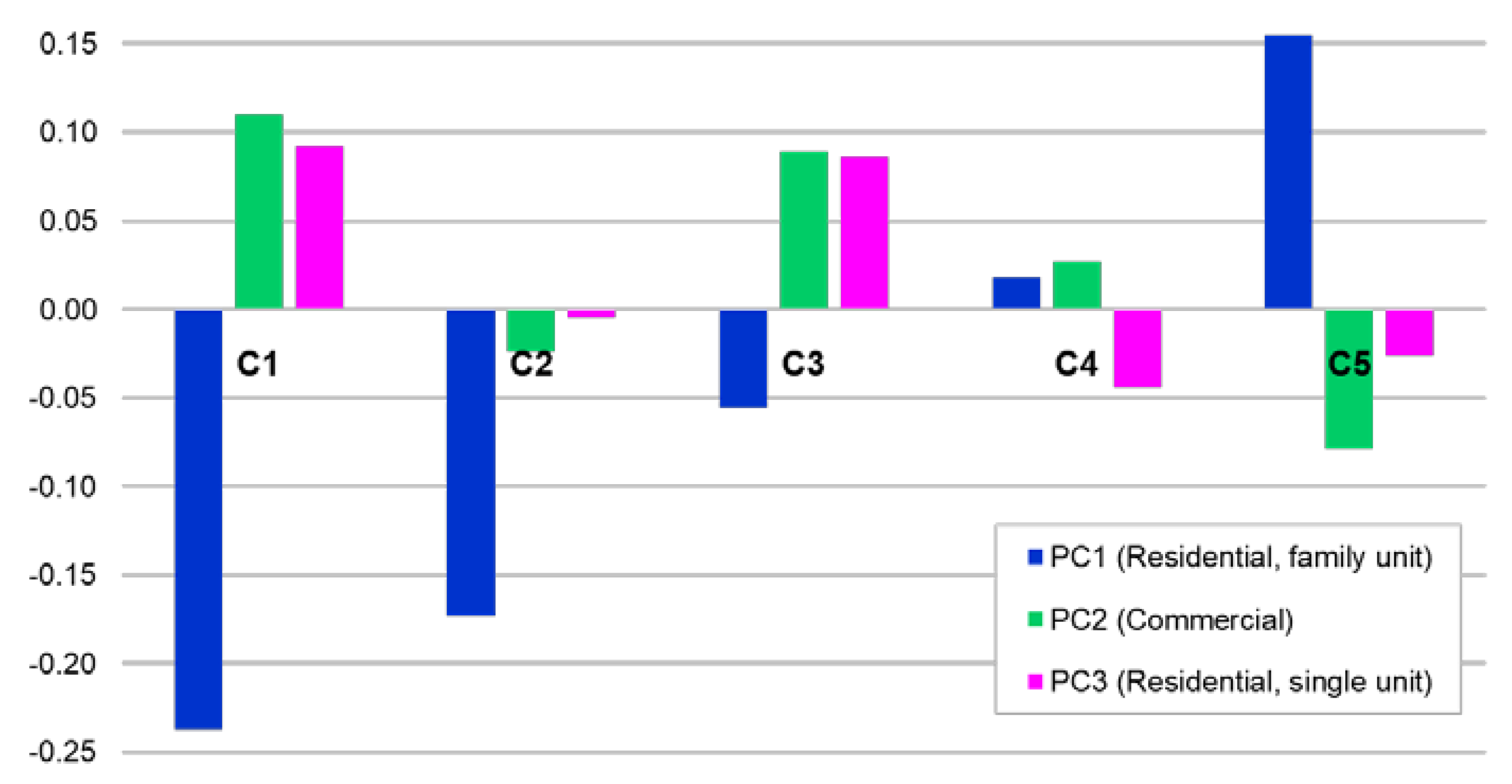

| Transaction Number | Boarding Time (yyyy/mm/dd/hh/mm/ss) | ID of Boarding Location | Alighting Time (yyyy/mm/dd/hh/mm/ss) | ID of Alighting Location | Number of Passengers |
|---|---|---|---|---|---|
| 1 | 20150318092455 | 4196066 | 20150318092714 | 4196117 | 1 |
| 2 | 20150318214734 | 4196061 | 20150318215035 | 4196065 | 1 |
| 3 | 20150318225205 | 12174 | 20150318225855 | 8001017 | 1 |
| 4 | 20150318075726 | 70647 | 20150318082805 | 10585 | 1 |
| 5 | 20150318070948 | 216 | 20150318084718 | 4101317 | 1 |
| … | … | … | … | … | … |
| Category | Description | Variables |
|---|---|---|
| Population | Age/sex distribution | in_age_001~054 |
| Education level (type of last school completed) | in_edu_001~008 | |
| Marital status | in_wed_001~008 | |
| Household | Number of rooms | ga_co_001~011 |
| Type of occupancy | ga_po_001~006 | |
| Family type of household | ga_sd_001~006 | |
| Housing | Floor space of house | ho_ar_001~009 |
| Type of housing | ho_gb_001~006 | |
| Construction year | ho_yr_001~013 | |
| Business | Number of businesses by 9th industrial classification in Korea | cp9_bnu_01~18 |
| Number of employees by 9th industrial classification in Korea | cp9_bem_01~18 | |
| Land use/Land cover | Residential area | lcm_110 |
| Industrial area | lcm_120 | |
| Commercial area | lcm_130 | |
| Recreational facilities | lcm_140 | |
| Roads | lcm_150 | |
| Public facilities | lcm_160 | |
| Agricultural area | lcm_200 | |
| Forest | lcm_300 | |
| Grass | lcm_400 | |
| Wetland | lcm_500 | |
| Bare land | lcm_600 | |
| Water | lcm_700 |
| Major Variables | C1 | C2 | C3 | C4 | C5 |
|---|---|---|---|---|---|
| Socio-demographic characteristics | |||||
| Population | 2263 | 3209 | 4376 | 4512 | 5241 |
| Aging index * | 158 | 97 | 106 | 84 | 77 |
| Youth dependency ratio ** | 14 | 18 | 17 | 19 | 20 |
| Number of households | 943 | 1210 | 1702 | 1629 | 1878 |
| Number of houses | 613 | 849 | 1070 | 1199 | 1318 |
| Number of businesses | 753 | 313 | 347 | 231 | 224 |
| Number of employees | 6494 | 2226 | 2212 | 1225 | 853 |
| Land-use (LU) characteristics | |||||
| Residential area (%) | 29.46 | 36.61 | 43.42 | 47.87 | 55.90 |
| Industrial area (%) | 0.75 | 2.61 | 0.60 | 0.21 | 0.24 |
| Commercial area (%) | 36.02 | 25.64 | 21.20 | 15.27 | 14.06 |
| Recreational facilities area (%) | 0.52 | 0.65 | 0.93 | 0.52 | 0.48 |
| Roads (%) | 20.05 | 19.91 | 19.61 | 18.09 | 15.74 |
| Total area (km2) | 55.67 | 72.77 | 100.17 | 191.33 | 189.14 |
| Transportation characteristics | |||||
| Number of subway stations | 86 | 57 | 67 | 85 | 72 |
| Number of bus stops | 1424 | 1659 | 1757 | 3557 | 5096 |
| The average daily number of passengers (weekday) | 4,644,463 | 2,327,482 | 3,454,941 | 3,866,049 | 4,442,733 |
| The average daily number of passengers (weekend) | 3,010,399 | 1,501,063 | 2,997,360 | 2,814,313 | 3,232,683 |
| Boardings around the morning peak | 39,787 | 54,128 | 84,149 | 149,850 | 211,048 |
| Boardings around the evening peak | 210,410 | 85,978 | 108,961 | 102,927 | 97,835 |
| Alightings around the morning peak | 251,609 | 98,525 | 103,778 | 99,425 | 85,157 |
| Alightings around the evening peak | 93,492 | 59,103 | 104,576 | 120,964 | 157,452 |
© 2018 by the authors. Licensee MDPI, Basel, Switzerland. This article is an open access article distributed under the terms and conditions of the Creative Commons Attribution (CC BY) license (http://creativecommons.org/licenses/by/4.0/).
Share and Cite
Kim, M.-K.; Kim, S.; Sohn, H.-G. Relationship between Spatio-Temporal Travel Patterns Derived from Smart-Card Data and Local Environmental Characteristics of Seoul, Korea. Sustainability 2018, 10, 787. https://doi.org/10.3390/su10030787
Kim M-K, Kim S, Sohn H-G. Relationship between Spatio-Temporal Travel Patterns Derived from Smart-Card Data and Local Environmental Characteristics of Seoul, Korea. Sustainability. 2018; 10(3):787. https://doi.org/10.3390/su10030787
Chicago/Turabian StyleKim, Mi-Kyeong, Sangpil Kim, and Hong-Gyoo Sohn. 2018. "Relationship between Spatio-Temporal Travel Patterns Derived from Smart-Card Data and Local Environmental Characteristics of Seoul, Korea" Sustainability 10, no. 3: 787. https://doi.org/10.3390/su10030787




